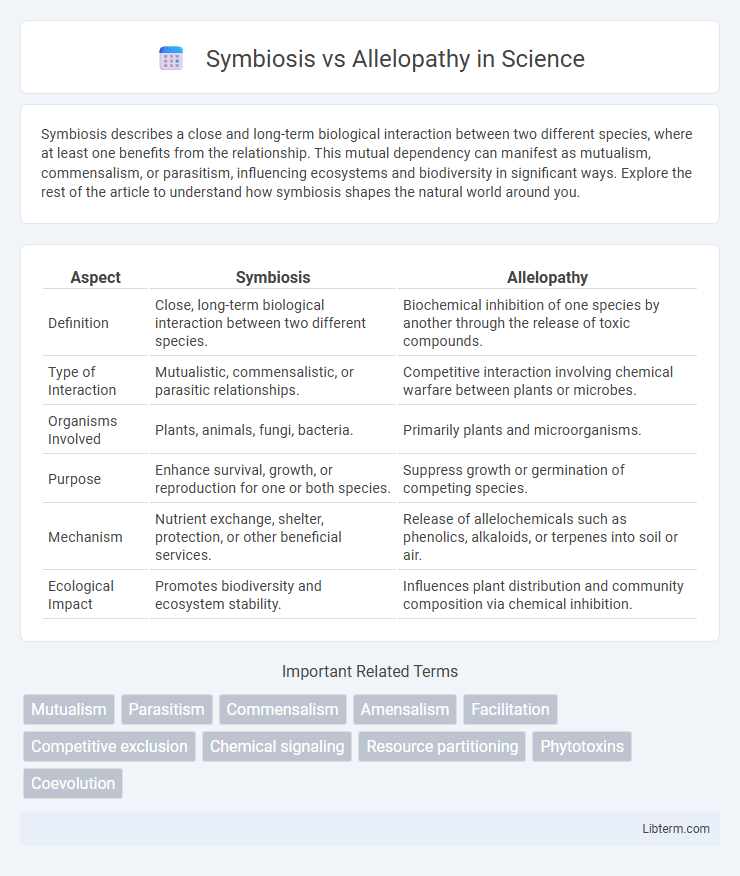Symbiosis describes a close and long-term biological interaction between two different species, where at least one benefits from the relationship. This mutual dependency can manifest as mutualism, commensalism, or parasitism, influencing ecosystems and biodiversity in significant ways. Explore the rest of the article to understand how symbiosis shapes the natural world around you.
Table of Comparison
| Aspect | Symbiosis | Allelopathy |
|---|---|---|
| Definition | Close, long-term biological interaction between two different species. | Biochemical inhibition of one species by another through the release of toxic compounds. |
| Type of Interaction | Mutualistic, commensalistic, or parasitic relationships. | Competitive interaction involving chemical warfare between plants or microbes. |
| Organisms Involved | Plants, animals, fungi, bacteria. | Primarily plants and microorganisms. |
| Purpose | Enhance survival, growth, or reproduction for one or both species. | Suppress growth or germination of competing species. |
| Mechanism | Nutrient exchange, shelter, protection, or other beneficial services. | Release of allelochemicals such as phenolics, alkaloids, or terpenes into soil or air. |
| Ecological Impact | Promotes biodiversity and ecosystem stability. | Influences plant distribution and community composition via chemical inhibition. |
Introduction to Symbiosis and Allelopathy
Symbiosis is a close and long-term biological interaction between two different biological organisms, which can be mutualistic, commensalistic, or parasitic, benefiting one or both parties involved. Allelopathy refers to the chemical inhibition of one plant species by another, where biochemicals released into the environment suppress the growth and development of neighboring plants. Both phenomena play crucial roles in ecological relationships and influence plant community dynamics, biodiversity, and ecosystem functioning.
Defining Symbiosis: Mutual Benefits in Nature
Symbiosis refers to a close and long-term biological interaction between two different species where both organisms benefit from the relationship, enhancing survival and reproduction. Mutualistic symbiosis includes examples like the association between nitrogen-fixing bacteria and leguminous plants, where bacteria provide essential nutrients while receiving carbohydrates. This cooperative interaction contrasts with allelopathy, where one species releases biochemicals to inhibit the growth of competing plants, highlighting different ecological strategies in nature.
Exploring Allelopathy: Chemical Interactions Among Plants
Allelopathy involves the release of biochemical compounds by plants that inhibit or stimulate the growth of neighboring plants, impacting plant competition and community dynamics. These chemical interactions function through root exudates, leaf leachates, or volatilized substances, influencing seed germination, growth rate, and nutrient uptake. Understanding allelopathic mechanisms is crucial for developing sustainable agricultural practices and managing invasive species.
Key Differences Between Symbiosis and Allelopathy
Symbiosis involves close and long-term biological interactions between two different species, often benefiting both organisms, such as in mutualism or commensalism. Allelopathy refers to the chemical inhibition of one species by another through the release of biochemicals, impacting plant growth and germination negatively. The key difference lies in symbiosis fostering mutual or neutral relationships, while allelopathy primarily involves competitive chemical interference.
Types of Symbiotic Relationships
Symbiotic relationships include mutualism, where both species benefit, such as bees pollinating flowers; commensalism, where one species benefits without harming the other, like barnacles on whales; and parasitism, where one organism benefits at the expense of the other, as seen with ticks feeding on mammals. Allelopathy involves chemical inhibition where plants release biochemicals to suppress the growth of competing species, affecting plant distribution and community dynamics. Understanding the distinct ecological roles of symbiosis and allelopathy clarifies their impact on biodiversity and ecosystem balance.
Common Examples of Allelopathy in Ecosystems
Allelopathy refers to the chemical inhibition of one plant species by another through the release of toxic compounds, commonly seen in black walnut (Juglans nigra) trees that secrete juglone inhibiting growth of nearby plants. Another well-known example is the eucalyptus tree, whose leaf litter releases allelochemicals suppressing understory vegetation. Rice paddies also demonstrate allelopathy where certain rice varieties release phytotoxins that reduce weed proliferation, enhancing crop yield and ecosystem balance.
Ecological Impacts: Symbiosis vs Allelopathy
Symbiosis enhances ecosystem stability by fostering mutually beneficial relationships between species, such as nitrogen-fixing bacteria and plants, which improve soil fertility and plant growth. Allelopathy impacts ecological balance by releasing biochemicals that inhibit the growth of competing plants, often reducing biodiversity and altering community structure. The contrasting effects of symbiosis and allelopathy demonstrate their critical roles in shaping species interactions and ecosystem dynamics.
Evolutionary Significance of Both Processes
Symbiosis and allelopathy play pivotal roles in evolutionary biology by driving species interactions that influence survival and adaptation. Symbiosis fosters mutualistic relationships enhancing resource sharing, nutrient acquisition, and co-evolutionary dynamics, often leading to increased biodiversity and ecosystem stability. Allelopathy exerts selective pressure through chemical inhibition, shaping plant community structures and promoting competitive exclusion, thereby guiding evolutionary trajectories in densely populated habitats.
Applications in Agriculture and Environmental Management
Symbiosis enhances crop productivity and soil health by promoting nutrient exchange and mutualistic relationships between plants and microorganisms, such as mycorrhizal fungi and nitrogen-fixing bacteria. Allelopathy offers natural weed control by releasing bioactive compounds that suppress weed growth, reducing reliance on synthetic herbicides and supporting sustainable agriculture. Both processes contribute to environmental management through improved soil fertility, biodiversity conservation, and integrated pest management practices.
Conclusion: Understanding Plant Interactions for Ecological Balance
Symbiosis and allelopathy represent critical plant interaction mechanisms that significantly influence ecological balance by enhancing biodiversity and resource distribution. Symbiosis fosters mutual benefits between species, such as nutrient exchange in mycorrhizal relationships, whereas allelopathy involves chemical inhibition affecting plant competition and community dynamics. Understanding these interactions enables improved ecosystem management and supports sustainable agricultural practices by promoting natural plant coexistence and reducing reliance on synthetic inputs.
Symbiosis Infographic

 libterm.com
libterm.com